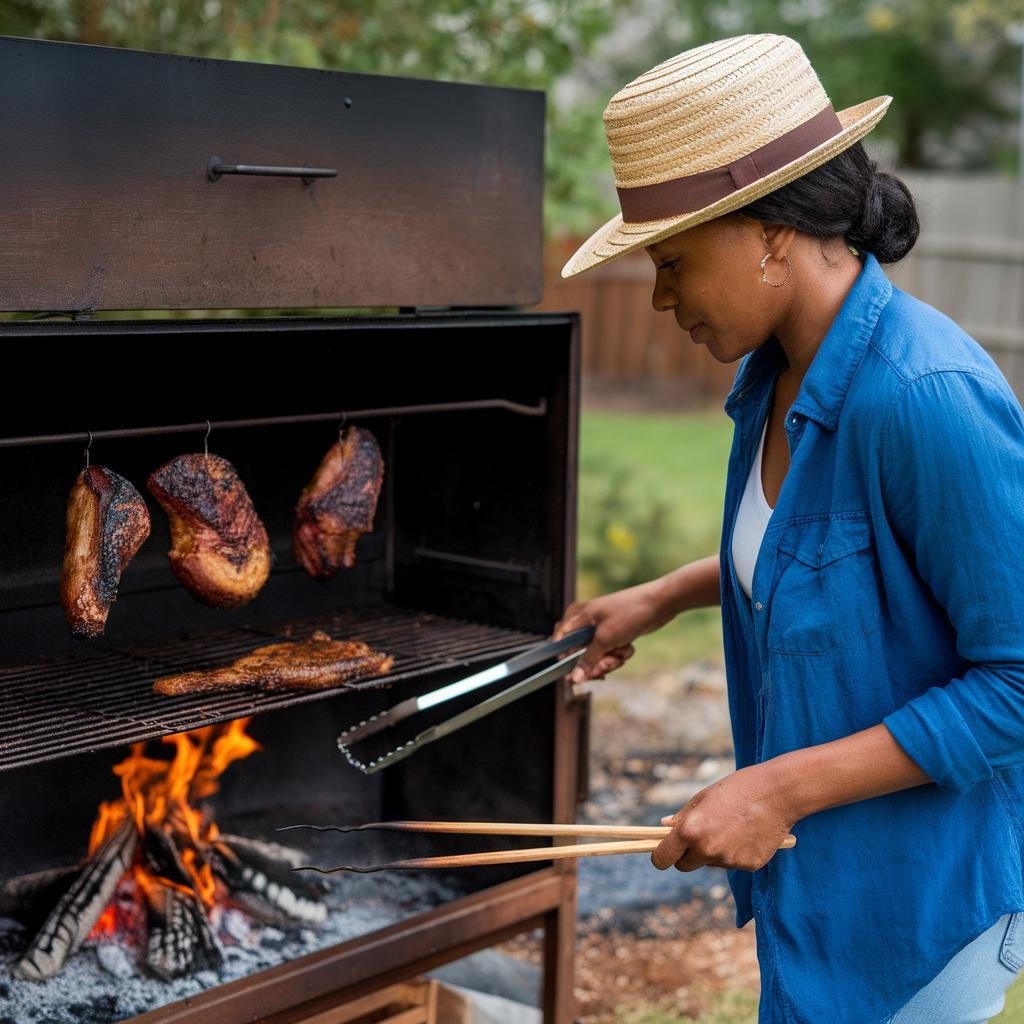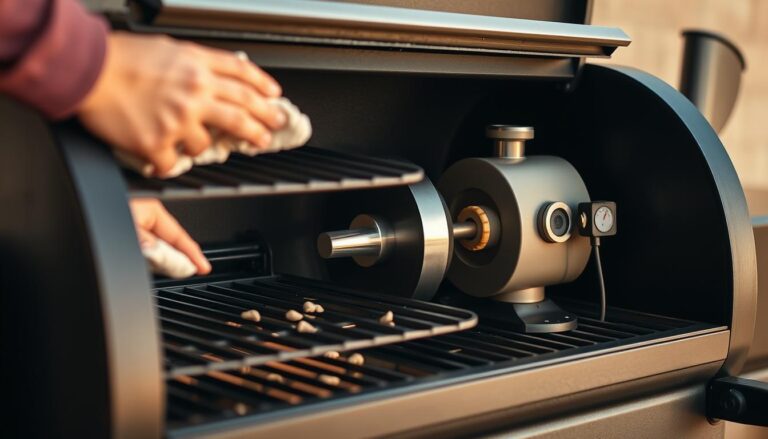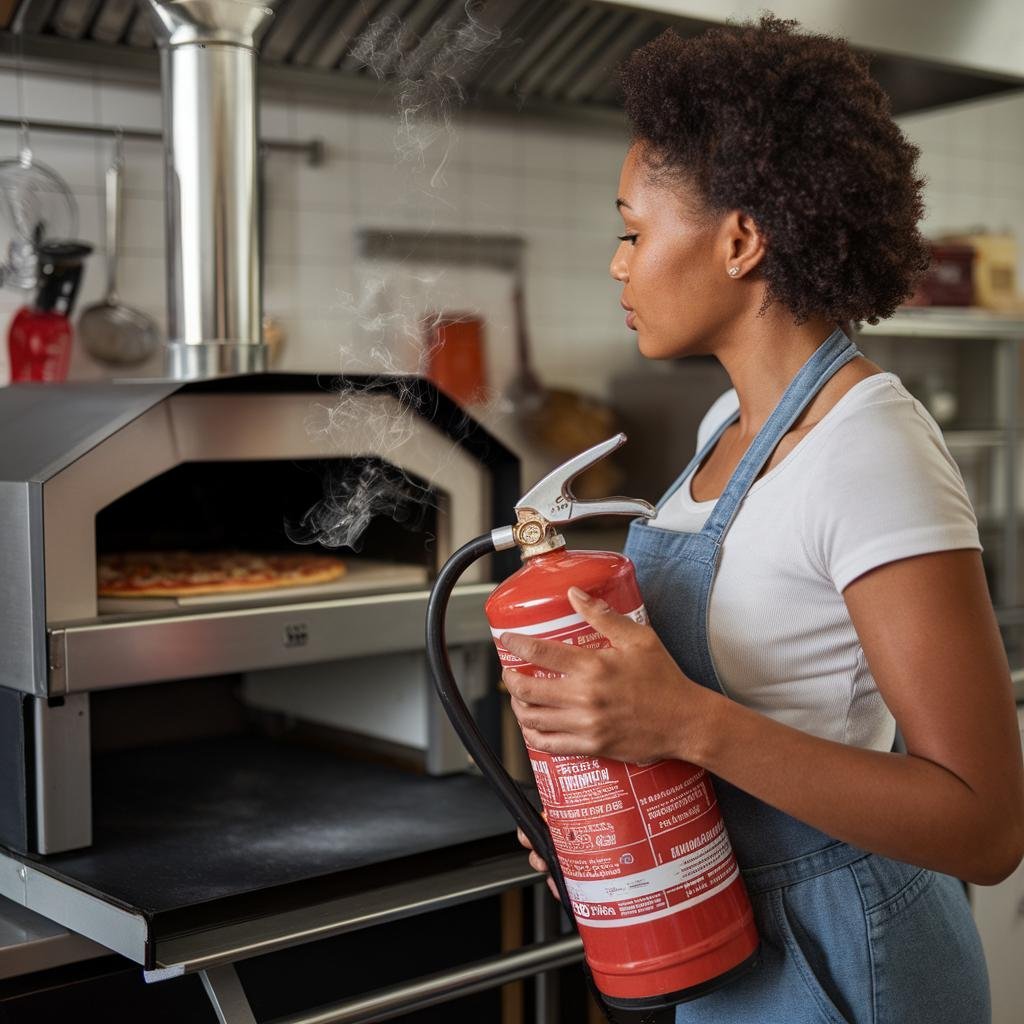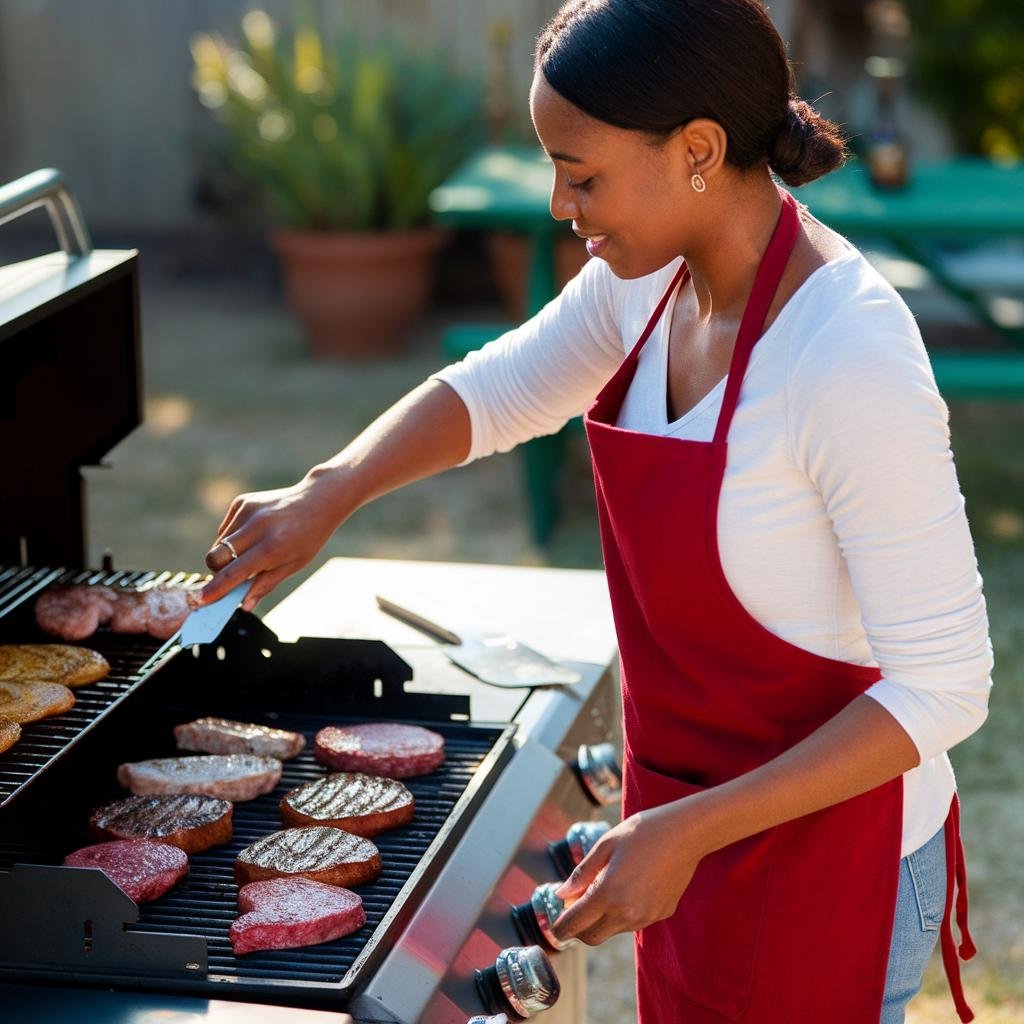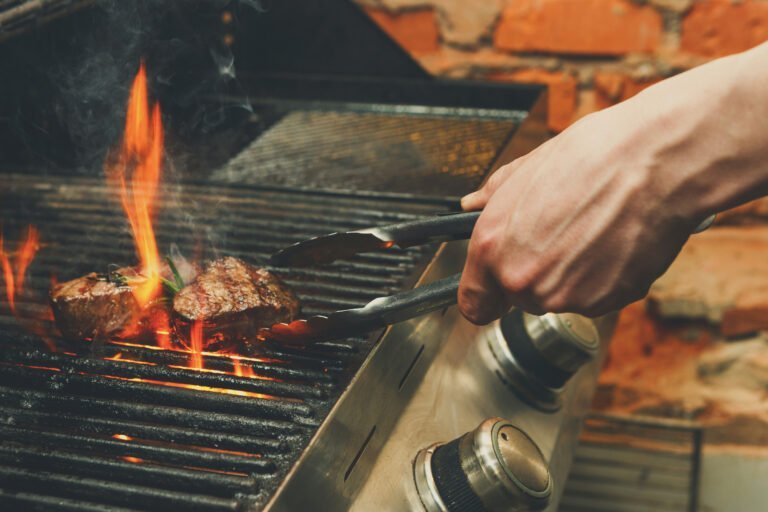Disclosure: This Post Contains Affiliate Links; We earn a commission on purchases.
Welcome to our comprehensive guide on troubleshooting your smoker. We understand the frustration that can arise when your BBQ smoker encounters problems, whether it’s not heating up properly, experiencing temperature fluctuations, or having issues with smoke production and airflow. In this article, we will provide you with a step-by-step troubleshooting guide to help you resolve these common issues and get your smoker back in top shape for your next grilling session.
Key Takeaways:
- Identify and resolve power issues, such as a tripped GFCI or faulty power outlet, to ensure your smoker powers on and lights up.
- Address temperature issues by checking for lack of power to the fan, a grease-seized fan, obstructions preventing the fan from turning, or auger problems.
- Tackle smoke production problems by inspecting the smoke generator, ensuring the pellets are dry and of high quality, and cleaning the smoker regularly.
- Improve airflow by troubleshooting the induction fan and auger issues, ensuring they are functioning properly to maintain consistent temperature and smoke production.
- Follow essential maintenance tips to keep your smoker in optimal condition, including regular cleaning, inspecting and replacing components, and using high-quality pellets.
Power Issues: Grill Won’t Power On or Light
Power problems can be frustrating when your smoker won’t turn on or light up. To troubleshoot these issues, it’s important to check for common causes and make necessary repairs or replacements. Here are some possible reasons why your smoker is experiencing power issues:
1. Tripped GFCI
A Ground Fault Circuit Interrupter (GFCI) is a safety device designed to protect against electrical shock. If your smoker is connected to a GFCI outlet and it trips, it can cause your smoker to lose power. To fix this, check the outlet and reset the GFCI if necessary.
2. Faulty Power Outlet
A faulty power outlet can also prevent your smoker from powering on. Inspect the outlet for any visible damage or signs of wear. If needed, replace the outlet to restore power to your smoker.
3. Blown Fuse
The controller of your smoker may have a fuse that can blow due to power surges or other electrical issues. Check the controller for any blown fuses and replace them if necessary. Refer to your smoker’s manual for guidance on fuse replacement.
4. Faulty Extension Cord
If you are using an extension cord to connect your smoker to a power source, it’s possible that the cord may be faulty or damaged. Try using a different extension cord or connect your smoker directly to a power outlet to see if it resolves the issue.
5. Induction Fan Not Running
The induction fan in your smoker is responsible for circulating air and maintaining the internal temperature. If the fan is not running, it can prevent your smoker from heating up. Inspect the fan for any obstructions or signs of failure. If necessary, replace the fan to restore proper airflow.
6. Hotrod Failure
The hotrod in your smoker is the heating element that ignites the pellets and generates heat. If the hotrod fails, your smoker won’t light up. Check the hotrod for any visible damage or signs of wear. If needed, replace the hotrod to restore ignition.
By identifying and addressing these power issues, you can get your smoker up and running again. If you are unsure or uncomfortable with performing these repairs yourself, it’s best to consult a professional.
| Possible Causes | Solutions |
|---|---|
| Tripped GFCI | Reset the GFCI and check for any underlying issues |
| Faulty Power Outlet | Inspect and replace the faulty power outlet |
| Blown Fuse | Check and replace blown fuses in the controller |
| Faulty Extension Cord | Use a different extension cord or connect directly to a power outlet |
| Induction Fan Not Running | Inspect and replace the induction fan if necessary |
| Hotrod Failure | Check and replace the faulty hotrod |
Temperature Issues: Smoker Not Heating or Fluctuating Temperatures
When it comes to smoking your favorite meats, maintaining the right temperature is crucial for achieving delicious results. However, you may encounter issues where your smoker is not heating properly or experiencing temperature fluctuations. These problems can significantly impact the cooking performance of your smoker. Let’s explore some troubleshooting steps to help you address these temperature issues.
Lack of Power to Fan
One possible cause of your smoker not heating is a lack of power to the fan. The fan is responsible for circulating air and maintaining a consistent temperature inside the smoker. If the fan is not receiving sufficient power, it can lead to inadequate heat distribution. To troubleshoot this issue, check the power supply and make sure it is correctly connected. Additionally, inspect the power cord for any damages or malfunctions.
Grease-Seized Fan
Another common problem that can affect temperature control is a grease-seized fan. Over time, grease and residue can accumulate on the fan blades, making it difficult for the fan to operate efficiently. This can result in improper heat circulation and temperature fluctuations. To resolve this issue, thoroughly clean the fan blades using a mild detergent and a soft brush. Ensure the fan is completely dry before reassembling and using the smoker.
Obstructions Preventing Fan from Turning
Sometimes, obstructions such as debris, ash, or foreign objects can obstruct the movement of the fan, leading to temperature problems. It’s essential to regularly inspect and clean the fan area to ensure there are no obstructions. Use a brush or compressed air to remove any debris and ensure smooth movement of the fan.
Moist Pellets Jamming Auger
If your smoker utilizes wood pellets for fuel, moisture can be a common issue. Moist pellets can jam the auger, preventing a consistent flow of fuel into the firebox and resulting in temperature fluctuations. To avoid this problem, store your pellets in a dry, airtight container. It’s also advisable to preheat the pellets before adding them to the smoker to remove any moisture.
Broken Gear or Shear Pin in Auger Motor
In some cases, a broken gear or shear pin in the auger motor can cause temperature issues. These components are responsible for transferring power to the auger, which feeds the fuel into the smoker. If they are damaged, the fuel flow may be disrupted, leading to inadequate heat production. Carefully inspect the auger motor and replace any broken gears or shear pins to restore proper functionality.
By troubleshooting these common temperature issues, you can ensure that your smoker provides consistent and reliable heat for optimal cooking results. Remember to consult the manufacturer’s manual or seek professional assistance if you encounter complex problems that require expert guidance.
Stay tuned for the next section, where we will discuss smoke production problems and how to address them.
Smoke Production Problems: Insufficient Smoke or Excessive Smoke
Smoke production is key to achieving that delicious smoky flavor in your food. However, if your smoker is experiencing issues with smoke production, it can greatly affect the taste and overall cooking experience. This section will provide troubleshooting tips to address two common smoke production problems:
Insufficient Smoke Production
Insufficient smoke production can result in a mild flavor that lacks that rich smokiness we crave. Here are some potential causes and troubleshooting steps to overcome this problem:
- Clogged or Damaged Smoke Generator: Check the smoke generator for any clogs or damage that may be restricting smoke output. Clear any obstructions and repair or replace damaged parts as necessary.
- Wet or Low-Quality Pellets: Moisture in the pellets can hinder smoke production. Ensure your pellets are stored in a dry area and invest in high-quality pellets for better smoke output.
- Ash Buildup: Excessive ash can disrupt the airflow and hinder smoke production. Regularly clean out the ash from your smoker’s firebox, ensuring proper ventilation and smoke generation.
- Dirty or Unkempt Smoker: A buildup of grease, residue, and debris in your smoker can affect smoke production. Clean your smoker regularly, paying attention to the smoke generator and other vital components.
Excessive Smoke Production
While smoky flavor is desired, excessive smoke can overpower the taste of your food and make it unpleasant. Here are some potential causes and troubleshooting steps to address excessive smoke production:
- Clogged Smoke Generator: A clogged smoke generator can cause an excessive amount of smoke. Clean out any debris or obstructions to restore proper smoke output.
- Wet or Low-Quality Pellets: Using wet or poor-quality pellets can result in excessive smoke. Ensure your pellets are dry and invest in pellets from reputable brands for consistent smoke production.
- Ash Buildup: Excessive ash accumulation can disrupt airflow and lead to excessive smoke. Regularly clean out ash from your smoker to maintain proper smoke generation.
- Dirty or Unkempt Smoker: A smoker that is not clean or properly maintained can contribute to excessive smoke production. Clean your smoker’s interior, grates, and other surfaces to minimize excessive smoke.
Remember, achieving the perfect balance of smoke production is essential for enhancing the flavor of your dishes. By troubleshooting and addressing these smoke production problems, you can ensure a delightful smoky taste in every bite.
For a visual representation of the potential causes and troubleshooting steps for smoke production problems, refer to the table below:
| Issue | Potential Causes | Troubleshooting Steps |
|---|---|---|
| Insufficient Smoke Production | Clogged or Damaged Smoke Generator Wet or Low-Quality Pellets Ash Buildup Dirty or Unkempt Smoker | Clear clogs or repair/replace smoke generator components Store pellets in a dry area and use high-quality pellets Clean out ash regularly to ensure proper ventilation Maintain a clean smoker by regularly cleaning and removing grease, residue, and debris |
| Excessive Smoke Production | Clogged Smoke Generator Wet or Low-Quality Pellets Ash Buildup Dirty or Unkempt Smoker | Clear obstructions in the smoke generator Ensure pellets are dry and opt for high-quality pellets Regularly clean out ash for proper airflow Thoroughly clean the smoker’s interior and surfaces to reduce excessive smoke |
By identifying and resolving these smoke production problems, you can elevate your grilling experience and enjoy perfectly smoked dishes every time.
Airflow Troubleshooting: Fan and Auger Issues
Proper airflow is crucial for maintaining consistent temperature and smoke production in your smoker. When the airflow is disrupted, it can result in undercooked or overcooked food and an ineffective smoking process. In this section, we will explore common issues that can arise with the fan and auger in your smoker and provide troubleshooting steps to resolve them.
Induction Fan Not Turning
The induction fan plays a vital role in circulating air inside the smoker. If the fan is not turning, it can impede airflow and affect the temperature distribution. Possible causes for an induction fan not turning include a faulty motor or electrical connection. To troubleshoot this issue:
- Check if the fan blades are obstructed by any debris, such as grease or food particles. Clean the blades and ensure they can move freely.
- Inspect the electrical connections of the fan motor. If there is any visible damage or loose wiring, consider repairing or replacing the motor.
- Ensure that the power supply to the fan is working properly. Test the voltage using a multimeter or consult an electrician for assistance.
Lack of Power to Fan
If the fan lacks power, it may not function correctly, leading to inadequate airflow. Here are some steps to address the lack of power to the fan:
- Check the power source and ensure it is providing sufficient electricity to the fan.
- Inspect the electrical connections between the power source and the fan. If there are any damaged or loose wires, consider repairing or replacing them.
- If you are using an extension cord, make sure it is suitable to handle the power load required by the fan. Consider using a heavy-duty extension cord if necessary.
Grease-Seized Fan
Over time, the fan in your smoker can accumulate grease, causing it to become seized and unable to rotate properly. To resolve this issue:
- Disconnect the power supply to the smoker to ensure safety.
- Remove the fan from the smoker and clean it thoroughly using a degreaser or soapy water.
- Once the fan is clean, dry it completely before reattaching it to the smoker.
Obstructions Preventing Fan from Turning
Obstructions like food particles, ash, or debris can hinder the movement of the fan, resulting in restricted airflow. To address this issue:
- Turn off and unplug the smoker.
- Inspect the fan and surrounding areas for any visible obstructions.
- Carefully remove any debris or blockages that are preventing the fan from turning.
- Ensure all components are securely reassembled before restarting the smoker.
Auger Jammed with Moist Pellets
The auger motor is responsible for feeding the smoker with wood pellets. If the auger becomes jammed with moist pellets, it can restrict the flow of fuel and airflow. Follow these steps to address an auger jam:
- Disconnect the power supply to the smoker.
- Remove any pellets from the hopper and clear the auger’s pathway.
- If the pellets are excessively moist, consider drying them or using dry pellets to avoid future jams.
- Ensure the auger moves freely before reassembling the smoker and restarting it.
Broken Gear or Shear Pin in Auger Motor
In some cases, a broken gear or shear pin in the auger motor can cause the auger to malfunction, affecting the airflow in the smoker. To troubleshoot this issue:
- Disconnect the power supply to the smoker.
- Inspect the auger motor for any visible damage or loose components.
- If a gear or shear pin is broken, replace it with a compatible part recommended by the manufacturer.
- Once the repair is complete, ensure the auger moves smoothly before restarting the smoker.
By addressing these common airflow issues, such as an induction fan not turning, lack of power to the fan, grease-seized fan, obstructions preventing the fan from turning, auger jammed with moist pellets, or a broken gear/shear pin in the auger motor, you can ensure optimal airflow in your smoker. This will result in consistent temperature control, smoke production, and a better overall grilling experience.
Smoker Maintenance Tips for Optimal Performance
Regular maintenance is essential for keeping your smoker in prime condition. By implementing these maintenance tips, you can ensure optimal performance and prolong the lifespan of your smoker.
Cleaning Your Smoker
Keeping your smoker clean is crucial for maintaining its functionality and preventing the buildup of grease and residue. Follow these steps to effectively clean your smoker:
- Start by disconnecting your smoker from the power source and allowing it to cool down.
- Remove the ash and debris from the firebox, as well as any leftover food particles from the cooking grates.
- Clean the interior and exterior surfaces of the smoker using warm soapy water and a non-abrasive sponge or cloth.
- Pay special attention to the smoke chamber, drip pan, and grease tray, as these areas tend to accumulate the most residue.
- Rinse off any soap residue with clean water and dry the smoker thoroughly before reassembling it.
Inspecting and Replacing Components
Regularly inspecting and replacing worn-out components is crucial for the proper functioning of your smoker. Here are some components to check and replace as needed:
| Component | Inspection | Replacement |
|---|---|---|
| Temperature Probe | Check for accuracy and proper connection. | Replace if damaged or faulty. |
| Gaskets and Seals | Inspect for wear and tear or signs of leakage. | Replace if worn out or damaged. |
| Igniter | Ensure it sparks consistently and lights the fuel source. | Replace if not functioning properly. |
| Auger Motor | Check for smooth operation and proper feeding of pellets. | Replace if jammed or malfunctioning. |
Storing Your Smoker Properly
Proper storage is essential to protect your smoker from the elements and prevent any damage during periods of non-use. Follow these tips for storing your smoker:
- Thoroughly clean your smoker before storage to remove any food residue or grease.
- Ensure the smoker is completely dry to avoid the growth of mold or mildew.
- Store your smoker in a cool, dry place, away from direct sunlight or extreme temperatures.
- Use a breathable cover to protect your smoker from dust and debris.
- Disconnect any power source or remove batteries to prevent the risk of electrical issues.
Using High-Quality Pellets
The fuel you use in your smoker plays a significant role in the flavor and performance of your food. Opt for high-quality pellets made from natural hardwood, as they burn more efficiently and produce better smoke. Avoid pellets that contain fillers or binders, as they may impact the taste and create more residue.
“Using high-quality pellets enhances the smoky flavor of your food while minimizing maintenance and ensuring optimal performance.”
By following these smoker maintenance tips, including proper cleaning techniques, inspecting and replacing components, storing your smoker correctly, and using high-quality pellets, you can ensure your smoker remains in excellent condition and delivers exceptional results every time.
Troubleshooting Tips for Specific Smoker Brands
While many troubleshooting tips apply to various smoker brands, some issues may be specific to certain models or brands. This section will provide brand-specific troubleshooting tips for Traeger grills, Pit Boss smokers, and Masterbuilt smokers with control panel issues. By addressing brand-specific problems, you can effectively troubleshoot and resolve any issues with your smoker.
Traeger Grill Troubleshooting:
If you are experiencing issues with your Traeger grill, refer to the following troubleshooting tips to get it back up and running:
- Check the power cord and make sure it is securely connected to the power outlet.
- Inspect the control panel for any error codes or error messages. Refer to the Traeger grill manual for specific instructions on how to address these errors.
- Ensure the temperature probe is properly inserted into the meat and not touching any bones or excessive fat.
- Clean the grill grates and remove any debris or excess grease that may be affecting the cooking performance.
- Verify that the auger motor is functioning correctly and not jammed with pellets.
Pit Boss Smoker Troubleshooting:
If you are facing issues with your Pit Boss smoker, consider the following troubleshooting tips to diagnose and fix the problem:
- Check the power source and ensure the smoker is properly plugged in.
- Inspect the control panel for any error codes or error messages. Refer to the Pit Boss smoker manual for specific instructions on how to troubleshoot these errors.
- Ensure there is adequate airflow in the smoker. Clean the air vents and remove any obstructions that may be hindering the ventilation.
- Verify that the heating element is functioning correctly and not faulty.
- Clean the smoker thoroughly and eliminate any excess ash or debris that may be affecting the smoker’s performance.
Masterbuilt Smoker Control Panel Issues:
If you’re encountering control panel issues with your Masterbuilt smoker, try the following troubleshooting steps to resolve the problem:
- Make sure the smoker is properly connected to a power source and the outlet is working.
- Check the control panel for any error codes or error messages. Consult the Masterbuilt smoker manual for specific instructions on addressing these errors.
- Ensure the control panel is clean and free from any moisture or debris that may affect its functionality.
- Verify that the temperature settings are accurate and adjusted according to your desired cooking temperature.
- If the issue persists, contact Masterbuilt customer support for further assistance.
If you’re still experiencing issues with your smoker after following the troubleshooting tips provided for each brand, it’s recommended to consult a professional or reach out to the respective customer support for specialized assistance.
Conclusion
Troubleshooting your smoker can be frustrating, but with the right knowledge and guidance, you can easily resolve common issues. Throughout this article, we have provided you with a comprehensive set of troubleshooting tips for power issues, temperature problems, smoke production issues, airflow troubleshooting, smoker maintenance, and brand-specific problems. By following these tips, you can overcome common smoker problems and ensure a successful grilling experience.
Remember, when dealing with complex issues or if you’re unsure about any aspect of troubleshooting your smoker, it is always best to consult a professional for expert assistance. They can provide personalized guidance and ensure that you address the problem correctly.
Now armed with these troubleshooting tips, you can confidently tackle any challenges you may encounter and get the most out of your smoker. Enjoy the delicious flavors and aromas that come with the art of smoking, and happy grilling!
Source Links
- https://paylesshardwareandrockery.com/2023/07/10/traeger-grill/
- https://www.atgrillscookware.com/blogs/cooking/masterbuilt-smoker-control-panel-not-working
- https://www.frangosandfrangos.com/pit-boss-smoker-not-igniting-how-to-fix/

Ryan Conlon is a BBQ enthusiast and inspired chef on a journey through the smoky, savory world of outdoor cooking. Hailing from the heart of the Midwest, Ryan’s passion for grilling ignited during his early years, where family gatherings often revolved around the sizzle of the grill and the aroma of seasoned meats.

